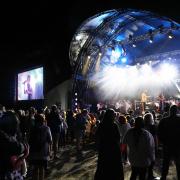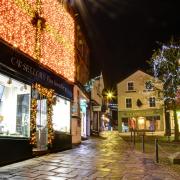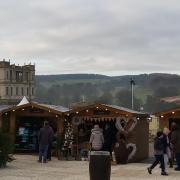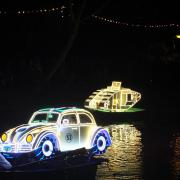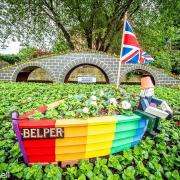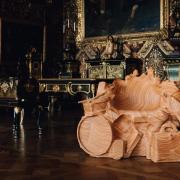Peter Seddon takes a cheery look at the county’s two worst winters... and muses how we might cope today

Bing Crosby perpetually dreams of one. Some bet on one. Young children innocently expect one. And incurable romantics of every age yearn for one. None of us could possibly be immune to the magical charms of a ‘White Christmas’ – nor the ‘Winter Wonderland’ that with luck lingers long into the New Year. It is beyond debate – as December dawns we all sing in unison that cheery chorus.... ‘Let it snow, let it snow, let it snow.’
But hark... postal workers and weary daily commuters aren’t joining in. Hospital x-ray departments seem to have forgotten the words. And Derbyshire County Council road-gritting teams have fallen to their knees in feverish prayer – please let it ‘not’ snow... especially not the ‘wrong type’. Even the ‘older generation’ who so love a festive sing-song remain curiously reluctant to summon snowfall. The word has a painful imagery – snow followed by fall... then those x-rays.
So the idyllic ‘White Christmas’ and glistening snowscape aren’t universally popular after all. Perhaps little wonder considering the havoc that even moderate snow curiously tends to bring in this high-tech age – school closures, travel chaos, fuel shortages, a desperate run on candles, fights over bags of rock salt. The trusty staples of a harsh winter – life as we know it falling apart.
It’s the perfect cue for those beyond a certain age to sagely remind the younger elements that they’ve seen it all before... but of course much worse. It’s a well-rehearsed mantra: ‘Not a patch on 1947 – or the “Big Freeze” of 1963. They were what you call winters – get those again and we’ll grind to a complete standstill.’

Those senior memories do not lie. And they surely have a valid point on today’s diminished levels of resilience. The early months of 1947 were the snowiest in living memory. The opening to 1963 proved ‘the coldest winter since 1740’. On both occasions Derbyshire suffered worse than some – and amid the disruption each of those bitter spells yielded tragedies which made national headlines.
Whilst not the coldest, 1947 suffered the most snow within living memory, harsh enough to rank fourth in the ten worst British winters of all time in the modern climatic age. ‘The Great Frost’ of 1683-84 tops the table, followed by a desperately severe 1739-40 in the midst of ‘the little ice age’. 1962-63 had less-prolonged snow than 1947 but comes in third for its numbing temperatures.
Two things deepened the effects of the 1947 white-out. Its arrival was unexpected – and it hit a Britain yet to recover from the Second World War. Still suffering food rationing and fuel shortages – genuine ‘austerity’ in the true sense of that overworked word – Arctic conditions were the last thing the country needed.
Yet over Christmas 1946 there was no real sign of the chaos to come. Winter sun ushered in a bright new year, and curiously mild temperatures prevailed for several weeks. But an area of high pressure over Southern Scandinavia put paid to that, setting up a weather pattern which brought the first snow fall to Southern England on the 23rd January. This quickly spread north and carried on – from then until the thaw began in late March snow fell somewhere in the country for 55 days running.

Much of it settled because temperatures remained low. As snow fell on snow the ground remained deeply covered throughout February – then unusually strong winds in March created blizzard conditions which caused widespread drifting... in the higher parts of Derbyshire up to 20 feet deep.
But even before then many Derbyshire roads had become impassable – with inevitable consequences. On 4th February 1947 the Derby Evening Telegraph painted a bleak scene: ‘Scores of Derbyshire towns and villages were today cut off completely, and from all parts of the county came stories of marooned buses and mail vans, dislocated road and rail transport, and stranded lorries and cars.’
Meanwhile a national coal shortage – supplies already depleted by the war years – was worsened as essential supplies failed to get through to the power stations. Again with unwelcome consequences reported: ‘Homes in Allenton were without electricity today when Derby Corporation power station reduced its load by ten per cent. Even so, an official of the Central Electricity Board described the cut as “not quite as bad as we feared.”’
Yet soon those very cuts caused many industries and businesses first to slow down then close for the duration. This was dubbed the ‘Shinwell Shutdown’ in ‘honour’ of the Labour government’s beleaguered Minister of Fuel Emanuel ‘Manny’ Shinwell – accused by economic experts of blind complacence in failing to restore post-war coal stocks quickly enough. He later became Lord Shinwell.

Most schools doggedly remained open as children simply wrapped up, trudged in and revelled in the adventure. But by mid-February Derby had 20,000 workers idle. Derbyshire’s pits and quarries became unworkable. And some pubs ran completely dry of beer as deliveries failed. What then must a man do? Roundly abuse the government naturally!
In response to the crisis Prime Minister Clement Atlee broadcast to the nation – no television yet – urging the public to make greater economies with fuel. Yet still the weather worsened. Communities did pull together, the Derby Evening Telegraph gamely championing the Dunkirk spirit: ‘ON WITH THE MAIL. Mrs. Wallace, 63-years-old post-woman at Kirk Langley, was out early today delivering letters to isolated farms.’
Helped by such heroics – ‘claims culture’ not yet born – both county and country stoically came through. After one final crisis – widespread flooding when the thaw began in mid-March – normality returned. But not before the Peak District had suffered particular tragedy. During the morning of 13th February 1947 a Halifax bomber trying to drop food supplies to the Staffordshire village of Butterton near the Derbyshire border crashed on Grindon Moor killing all eight on board. Two of the victims rest eternal in Buxton.
A memorial marks the crash site, and in Grindon church a plaque and tapestry remember the lost. Ironically Butterton locals later insisted they had ‘quite sufficient food to last’, and critics suggested the mercy mission smacked of a government public relations exercise. It was certainly considered ‘unusual’ that two journalists had been aboard the stricken aircraft.
Those who lived through the winter of 1947 would always recall it when harsh conditions arrived in future. Sixteen years later in 1963 it was routinely cited as ‘much worse than this one’ – but although 1963 did have less snow, it was consistently colder than 1947, and as such has been ranked ‘third worst winter of the modern age.’
This time it began earlier. Snow in Glasgow on Christmas Day 1962 gave the city its first White Christmas since 1938. This surprising statistic presaged much more to come. Snow swept into Derbyshire on Boxing Day and soon the ‘Big Freeze’ set in. An A.A. official had a game if misguided stab at levity by saying ‘the only thing coming up the M1 is more snow.’ His R.A.C. counterpart lamely parried with ‘the Peak district looks like the Alps’. Perchance he’d seen the skiers enjoying a rare frolic in Edale.
Again services were widely disrupted – some of the proposed energy-saving solutions mildly comedic. Deep into the coldest January of the 20th century an Electricity Board bigwig earnestly urged the nation’s housewives to ‘delay your ironing as long as possible’. In some coastal parts the sea froze over – and a particular casualty was the programme of football matches, countless League and Cup games postponed week after week. Yet despite the icy cold there were many bright and sunny days – and a generation today ‘middle-aged’ might well recall 1963 as their joyous first experience of sledging and snowmen.
But amidst such fun there was again tragedy in the High Peak. On 4th February 1963 close to Derbyshire’s northernmost border two experienced climbers perished – found buried under 20 foot drifts at Wilderness Gully near the Chew Valley. Blessedly some lasting good emerged – as a result of this and further fatal incidents the Peak District Mountain Rescue Organisation was formed in 1964.
Now fifty years later 2015 is almost upon us. What sort of winter will it be? A certain newspaper expressly known for its outrageously alarmist weather predictions is already forecasting ‘the big one’, chillingly asserting that a cherished ‘White Christmas’ might easily herald a nightmare ‘Snowmaggedon’ even worse than the ‘Great Frost’ of 1683-84.
What to do? Take to our beds for the duration? Panic-buy soup and delay the ironing? Or draw on the intrepid spirit of Mrs Wallace the Kirk Langley postie? In truth as ever we’ll take what we get and emerge the other end more or less intact. ‘Twas ever thus – but a ‘47 or ‘63 would certainly make life interesting! Whatever you wish for – ‘Warm Seasons Greetings’... and have a good one!






